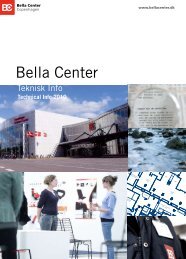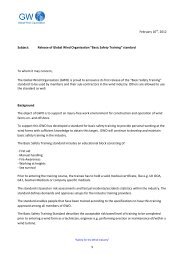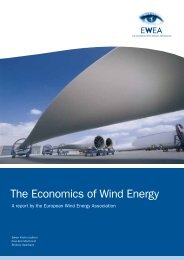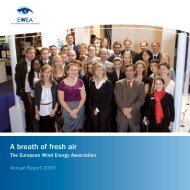Offshore Electricity Infrastructure in Europe - European Wind Energy ...
Offshore Electricity Infrastructure in Europe - European Wind Energy ...
Offshore Electricity Infrastructure in Europe - European Wind Energy ...
Create successful ePaper yourself
Turn your PDF publications into a flip-book with our unique Google optimized e-Paper software.
esults<br />
exist<strong>in</strong>g HVDC converters at each hub. Thus, the hub-tohub<br />
<strong>in</strong>vestment costs are relatively low.<br />
Along with these <strong>in</strong>frastructure <strong>in</strong>vestments the electricity<br />
generation costs (<strong>in</strong> Figure 4.24, red curve) <strong>in</strong><br />
the <strong>Europe</strong>an power system decrease. The annual<br />
generation cost curve shows - similar to the cumulative<br />
<strong>in</strong>vestment curve - l<strong>in</strong>ear reductions for the direct<br />
<strong>in</strong>terconnections, a flatten<strong>in</strong>g of the curve for the hub<br />
to hub cases and a further sharp reduction when the<br />
mesh is <strong>in</strong>troduced. The entire Direct Design reduces<br />
the system costs by €1.3 bn per annum (=€20.5 bn<br />
over 25 years) for a total <strong>in</strong>vestment cost of €7.4 bn.<br />
How large the benefit per <strong>in</strong>vestment is, is best shown<br />
<strong>in</strong> Figure 4.25. Here the net benefits (red bar) and the<br />
benefit-to-CAPEX ratio (blue marker) of each project are<br />
given for a life time of 25 years. In particular the meshed<br />
network exhibits a large benefit-to-CAPEX ratio. As all <strong>in</strong>vestments<br />
are beneficial and produce net benefits, the<br />
benefit-to-CAPEX ratio is always bigger than 100%. Some<br />
<strong>in</strong>vestments produce benefits of up to 7 times the <strong>in</strong>itial<br />
<strong>in</strong>vestment (benefit-to-CAPEX ratio of 700%).<br />
The f<strong>in</strong>al step of the meshed grid design creat<strong>in</strong>g a<br />
meshed network between Norway and Great Brita<strong>in</strong>,<br />
Germany, the Netherlands and Belgium generates<br />
significant net benefits over 25 years (€2.3 bn) for a<br />
FIGURE 4.25: GRId dESIGN: NET bENEFIT (REd, lEFT) ANd bENEFIT-TO-cAPEX RATIO (blUE, RIGhT)<br />
[€bN]. (PlEASE NOTE ThE dIFFERENcE bETWEEN NET bENEFIT ANd bENEFIT.)<br />
Net bene�t<br />
(red) (€bn)<br />
25<br />
20<br />
15<br />
10<br />
5<br />
0<br />
Base case<br />
SE-DE<br />
FI-EE<br />
SE-PL<br />
SE-DK<br />
SE-LV<br />
Direct <strong>in</strong>terconnections<br />
GB-FR<br />
SE-DE<br />
Net bene�ts (across lifetime)<br />
GB-BE<br />
GB-FR<br />
SE-PL<br />
relatively modest <strong>in</strong>vestment cost (€670 m) reach<strong>in</strong>g<br />
a benefit-to-CAPEX ratio of almost 400%. Aga<strong>in</strong>, this<br />
is because the additional <strong>in</strong>vestment is only <strong>in</strong> extra<br />
cabl<strong>in</strong>g, as the exist<strong>in</strong>g hub converters are utilised.<br />
4.5.3 The split design methodology<br />
The case <strong>in</strong>dependent model (section 4.4) clearly<br />
identified that splitt<strong>in</strong>g the connection of w<strong>in</strong>d farms<br />
(or hubs) to two separate shores can be a very cost<br />
effective and beneficial solution: the w<strong>in</strong>d farm is connected<br />
to shore and at the same time a relatively cheap<br />
<strong>in</strong>terconnector can be built. It was further identified that<br />
the splitt<strong>in</strong>g solution is most beneficial for large w<strong>in</strong>d<br />
farms or hubs which are far from the onshore connection<br />
po<strong>in</strong>t but are relatively close to another country,<br />
and when the price difference (see Annex D.III. for price<br />
level differences) between the two countries is high<br />
enough to make up for the additional <strong>in</strong>frastructure<br />
costs. As these f<strong>in</strong>d<strong>in</strong>gs presented a very promis<strong>in</strong>g<br />
grid design solution, the split w<strong>in</strong>d farm concept was<br />
taken <strong>in</strong>to account for the second methodology. Similar<br />
to the Direct Design methodology, the start<strong>in</strong>g po<strong>in</strong>t is<br />
the Hub Base Case scenario 2030 with hub-connected<br />
w<strong>in</strong>d farms and aga<strong>in</strong> the three-step methodology<br />
was applied. However, this time also split w<strong>in</strong>d farm<br />
connections were considered <strong>in</strong> the first step. Even<br />
though the second and third steps for the Split Design<br />
Bene�t-to-CAPEX<br />
ratio (blue) %<br />
64 <strong>Offshore</strong>Grid – F<strong>in</strong>al Report<br />
SE-DK<br />
IE-FR<br />
Hub-to-hub Mesh<br />
Omitted as not bene�cial. Shown to compare with direct design<br />
IE-GB<br />
GB-BE<br />
NO-NL<br />
SE-DK<br />
Bene�t CAPEX ratio (across lifetime)<br />
NL-GB<br />
GB-DE<br />
Mesh<br />
800<br />
700<br />
600<br />
500<br />
400<br />
300<br />
200<br />
100<br />
0









